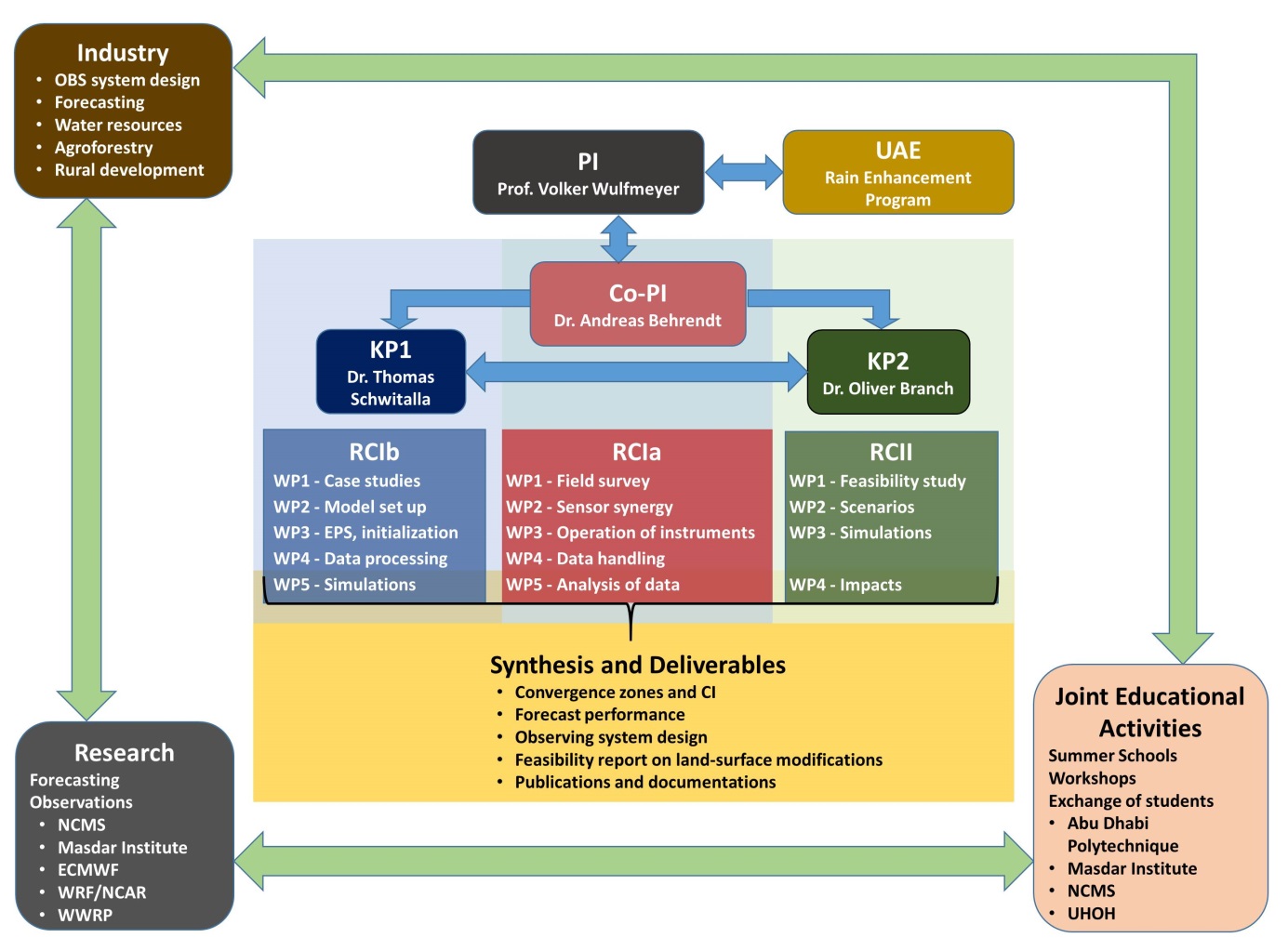Structure of the OCAL project
For this project, the head and Managing Director of the Institute of Physics and Meteorology (IPM) at the University of Hohenheim (UHOH), Prof. Dr. Volker Wulfmeyer, is responsible. The management structure and the national and international collaboration are depicted in Fig.1.
Prof. Wulfmeyer will report to the UAE Program on Rain Enhancement Science. He takes care that the overarching goals of the project are achieved by overseeing both the model development and forecasting as well as the deployment and application of the remote sensing systems.
As Co-PI, the head of the IPM Remote Sensing Working Group, Dr. Andreas Behrendt, is responsible for RCIb, namely the operation of the remote sensing systems and the performance of the field work.
The PIs will guide the Key Personnel (KP), Postdoc 1, Dr. Thomas Schwitalla, and Postdoc 2, Dr. Oliver Branch, with respect to the performance of their RCs and WPs. The shading of the boxes indicates that RCIa will be a joint task of both Postdocs. Furthermore, the overlapping shading of the final WPs of all RCs demonstrate that these are considered as synthesis packages. Here, the results are compared and exchanged leading to a harmonized overview of the results of our project.

Fig.1: Project management, hierarchy of decision processes and interaction with project partners with respect to R&E. The coordination of the work of the Postdocs and their interaction is indicated by the shading and overlaps of the RCs. The project will be imbedded in extensive activities with respect to knowledge transfer, capacity building, and involvement of industry.
As communication platforms and methods, we consider meetings and workshops of several days to be most useful. Furthermore, we will realize an exchange of scientists and students, which will be prepared and performed with this project. Both efforts provide the time for information exchange, training, and discussions. We will also set up internet tools for intensifying discussions such as video conferences, wiki discussion fora, and ftp servers.
We have scheduled a series of three meetings at UAE (Kick-off), UHOH (mid-term meeting), and UAE (final) with durations of several days. Further meetings are possible during the international workshops and spring schools and can be scheduled according to demand. Their subject will be the discussion of scientific progress, the joint use of instrumentation and data, process understanding, model verification strategies, and project management issues. These meetings will also provide a platform for the preparation and performance of knowledge transfer, capacity building, and outreach activities.
Furthermore, our project will strongly be connected with knowledge transfer and capacity building. Two international workshops/spring schools are planned, along with corresponding organization. The workshops will be scientific and the spring schools will be dedicated to education. The first workshop will deal with the application of new remote sensing systems for cloud seeding research and is proposed to take place in the UAE. The second workshop will focus on the understanding of convection initiation (CI) and the role of land use changes for the benefit of cloud seeding research and forecasting and will include high-resolution modeling and high-performance computing both with respect to R&E. A suitable location would be UHOH.
Additionally, Prof. Wulfmeyer is planning to perform his next sabbatical in the UAE, which will take place in 2018 with a duration of several months, to support strongly this project and the corresponding activities on knowledge transfer and capacity building.
Pitfalls and corrections in order to reach the project goals will be communicated with NCMS and the program managers of the UAE Research Program. Corresponding correction will be made by the PI after discussion in the team and only after agreement with UAE program managers.
The data collected within this project will come from the observations and from the model simulations. IPM has long-term experience in the handling of large data sets. After quality control, the observations will be stored on the Raid system of IPM (50 TB) and the 288 TB High-Performance Storage System (HPSS) at HLRS in Stuttgart, Germany. Afterwards, the data will be processed with IPM tools to different levels of detail for the research activities. The data are available for all project partners in the UAE such as NCMS and MI. The same holds for the model outputs. However, additional care needs to be taken to handle these very large data sets of the order of 10 TB. Here, the raw model output will remain at HLRS and will be directly archived and processed there. This is necessary to avoid significant time delays for their application in education and research. Only the processed data with considerably reduced size will be transferred to the IPM Raid server and to the project partners. IPM uses a variety of processing tools to provide model data with different structures such as time series, 3D fields, etc. upon request. The typical data format is NetCDF with detailed meta file description.

Fig.2: Time line of the project. After the preparatory meeting, site surveys and tests of the new instruments, measurements will be commenced. In summer 2017 and 2018, intense field campaigns will be conducted. After setting up the model system, the analyzed data will be assimilated and the model forecasts will be studied and verified. Knowledge transfer and capacity building will take place during the full project period. Spring workshops on research and educational topics will be organized in early 2017 and 2018.
